Home | Category: Baleen Whales (Blue, Humpback and Right Whales) / Toothed Whales (Orcas, Sperm and Beaked Whales)
WHALES
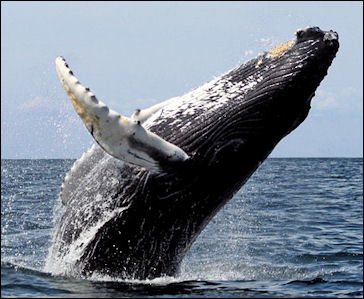
Humpback whale, a baleen whale Whales are warm-blooded, air-breathing marine mammals. They are the largest animals that ever lived, even larger than the largest dinosaurs. Like all mammals they have some hair. Most whale fetuses have hair on their heads but lose it by the time they are born. Some species of whale have small tufts of hair around their lips. Others have some near their blowholes or on bumps on their head.
Whale males are called bulls. Females are called cows. Young whales are called calves. Groups of whales are called herds, pods, schools, grinds or gams. The sex of whales, often difficult to determine, is identified by observing the genital slits. Some species, such as orcas (killer whales) and sperm whales are found in all of the world's seas. Others are limited to one hemisphere — such as Antarctic minke whales — or limited to an ocean —such as Sowerby's Beaked Whale (the northern Atlantic Ocean). Still others have highly restricted ranges. Stejneger's beaked whales are thought to live only in and around the Bering Sea. [Source: Eric J. Ellis and Allison Poor, Animal Diversity Web (ADW)]
There are two categories of whales: baleen whales and toothed whales (See Below). Baleen whales have filter-like baleens that allow then to feed on krill, fish and plankton. Blue whales, right whales, humpback whales. fin whales, gray whales and minke whales are all baleen whales. Toothed whales include sperm whales, narwhals, belugas, Baird's beaked whales, pilot whales, killer whales, bottlenose whales and dolphins and porpoises. Baleen whales evolved from toothed whale. This points is demonstrated by baleen whale fetuses that grow teeth while in the womb but reabsorb them before birth.
Whales live a long time. But because of the difficulties involved with tracking and studying cetaceans, lifespans are difficult to estimate. Available estimates suggest that most species live at least two decades, and some live much longer than that. A fin whale was reported to be 116. Bowhead whales may live over 200 years. In May 2007, Alaskan Eskimos caught a 50-ton bowhead whale and made an interesting discovery: impeded deep in the animal blubber was a harpoon point made in New Bedford, Massachusetts in the 1880s. It seems that the harpoon was fired sometime around then, making the age of the whale at least 130 years old. When other ways of measuring age were included the whale was estimated to be 212. See BOWHEAD WHALES ioa.factsanddetails.com
Related Articles: CATEGORIES: BALEEN WHALES (BLUE, HUMPBACK AND RIGHT WHALES) ioa.factsanddetails.com ; TOOTHED WHALES (ORCAS, SPERM AND BEAKED WHALES) ioa.factsanddetails.com; Articles: TOOTHED WHALES: SWIMMING, ECHOLOCATION AND MELON-HEADS ioa.factsanddetails.com; HISTORY OF WHALES: ORIGIN, EVOLUTION, SPECIES ioa.factsanddetails.com ; WHALE BEHAVIOR, FEEDING, MATING ioa.factsanddetails.com ; WHALE COMMUNICATION AND SENSES ioa.factsanddetails.com ; WHALING: HISTORY, TECHNIQUES ioa.factsanddetails.com ; ENDANGERED WHALES AND HUMANS ioa.factsanddetails.com ; BEACHED WHALES, SONAR AND THE U.S. NAVY ioa.factsanddetails.com ; BLUE WHALES: CHARACTERISTICS, SIZE, HISTORY, RANGE AND BIG HEART ioa.factsanddetails.com ; FIN WHALES: CHARACTERISTICS, BEHAVIOR, SUBSPECIES, FEEDING ioa.factsanddetails.com ; HUMPBACK WHALES: CHARACTERISTICS, FEEDING AND REPRODUCTION ioa.factsanddetails.com ; GRAY WHALES: CHARACTERISTICS, BEHAVIOR, FEEDING, REPRODUCTION, THREATS ioa.factsanddetails.com ; BOWHEAD WHALES: WORLD'S LARGEST MOUTH, SECOND BIGGEST ANIMAL AND MAY LIVE 212 YEARS ioa.factsanddetails.com ; RIGHT WHALES: CHARACTERISTICS, BEHAVIOR, FEEDING, REPRODUCTION ioa.factsanddetails.com ; BEAKED WHALES: SPECIES, CHARACTERISTICS, BEHAVIOR ioa.factsanddetails.com; SPERM WHALES: CHARACTERISTICS, SPECIES AND BIG HEADS AND BRAINS ioa.factsanddetails.com; ORCAS: CHARACTERISTICS, SIZE AND HABITAT ioa.factsanddetails.com; TYPES OF ORCAS: SPECIES, SUBSPECIES, ECOTYPES AND ORCA-LIKE SPECIES ioa.factsanddetails.com
Websites and Resources: Britain-based Whale and Dolphin Conservation Society uk.whales.org ; International Whaling Commission (IWC) iwc.in ; Animal Diversity Web (ADW) animaldiversity.org; National Oceanic and Atmospheric Administration (NOAA) noaa.gov; Fishbase fishbase.se; Encyclopedia of Life eol.org; Smithsonian Oceans Portal ocean.si.edu/ocean-life-ecosystems ; Monterey Bay Aquarium montereybayaquarium.org ; MarineBio marinebio.org/oceans/creatures. Books: “ The Grandest of Lives: Eye to Eye With Whales” by Douglas H. Chadwick (Sierra Club, 2006); “The Whale, In Search of the Giants of the Sea” by Philip Hoare (Ecco, 2010), a an erudite and literary look at whales and whaling and winner of the 2009 BBC Samuel Johnson Prize for Non-Fiction; “The Book of Whales” by Richard Ellis; “Secrets of the Whales” by Brian Skerry (2021). Videos: “Secrets of the Whales” is a 2021 National Geographic docuseries that premiered on Disney+. Shot at 24 locations around the world, it is produced by “Titanic” and “Avatar” director James Cameron and narrated by actress Sigourney Weaver. It is divided into four episodes focusing individually on orcas (killer whales), humpbacks and belugas, with the final episode featuring both sperm whales and narwhals.
Cetacea: Whales, Dolphins and Porpoises

anatomy of a killer whale, a toothed whale Whales, porpoises and dolphins are known to scientists as cetaceans. There are at least 93 cetacean species, including 65 species of whale. The skin of these creatures tends to be rubbery and smooth. The term Cetacea come from the Greek word ketos, which means “large sea creature”.
The order Cetacea comprises two extant sub-orders and one extinct sub-order. The extant sub-orders are Mysticeti (baleen whales) and Odontoceti (toothed whales). Both baleen whale and toothed whales are thought to be descendants of archaeocetes (Archaeoceti, ancient whales), an extinct sub-order. [Source: Eric J. Ellis and Allison Poor, Animal Diversity Web (ADW) /=]
There are at least 93 living species of cetaceans, with 46 genera in 14 families. New species are still being discovered. Of the two extant suborders, Odontoceti is larger and more diverse, with at least 70 species, 40 genera, and 10 families. Cetaceans, along with bats, are considered some of the most derived mammals on the planet. They evolved from terrestrial animals to an entirely aquatic life form that is completely separated from the land in all aspects of biology. Cetaceans live, breed, rest, and carry out all of their life functions in the water.
Cetaceans are exclusively aquatic. Most are species are marine, inhabiting coastal areas as well as the open ocean. A few species such as freshwater dolphins inhabit freshwater rivers. Others live in the brackish waters of estuaries.
Whale Characteristics
All cetaceans share a number of common characteristics. They have paddle-shaped front limbs; a laterally flattened tail with horizontal flukes at the end; vestigial hind limbs (which are within the body wall); no external digits or claws; and vestigial ear pinnae (the outer part of the ear). They have a basically hairless body (some young have hair on their snouts); telescoped skull bones;; a thick subcutaneous blubber layer filled with fat and oil; external blowholes (nares) on the top of their head; lack of sweat glands; internal reproductive organs; three-chambered stomach; and an airway reinforced with cartilage to the alveoli. [Source: Eric J. Ellis and Allison Poor, Animal Diversity Web (ADW) /=]
Whales are endothermic (use their metabolism to generate heat and regulate body temperature independent of the temperatures around them), homoiothermic (warm-blooded, having a constant body temperature, usually higher than the temperature of their surroundings) and have bilateral symmetry (both sides of the animal are the same). Cetaceans have diploid chromosome numbers of 42 to 44. Sexual dimorphism (differences between males and females) exists: Among some species females are larger than males. Blue whale females are larger than males. Among others males are larger. Ornamentation can be different. Many beaked whale males have enlarged, protruding teeth that females don't have.
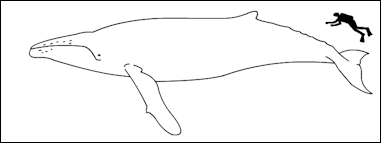
Humpback whale size Whales are streamlined like fish. They have fusiform body shape like a spindle or lemon and have no external genitals. All their sensory organs are recessed into slits so they can move through the water with less friction and drag. The fastest whales can swim at around 38 kilometers per hour (23 mph). Many whale characteristics are adaptations to reduce drag for fast swimming in an aquatic environment. Protuberances such as external ears or genitals would create turbulence, friction and drag. They have compressed vertebrae, which shortens the neck but increase speed
Most whales have a small dorsal fin, two flippers behind the head, one on each side, and a fin-like tail called a fluke, which is horizontal as opposed to vertical like the tail of fish. Whales move with powerful up and down and diagonal motions of their body and fluke as opposed to the side by side motion of fish. In “Moby Dick” Herman Melville wrote: “In no living thing are the lines of beauty more exquisitely defined than in the crescentic borders of these flukes.”
Whale bodies are covered by a thick layer of blubber — milky, white fat underneath a whale's skin.”that can be up to 80 centimeters deep and often makes more than half of the whales total body weight. Blubber is a great insulator in cold seas. It helps a whale store energy and provides nourishment when there isn't much to eat. Blubber also helps keeps whales a float. Starving whales often loose so much blubber they can no longer remain a afloat, and have to exert great effort into surfacing and breathing. Some perhaps die because they are too exhausted to surface.
Whales have skeletal features similar to land mammals. Their flippers have a similar skeletal structure as man's arm, hand and fingers. Their hind limbs have disappeared but a pelvis remains. The front flipper are remnants of forelimbs that date back to the days when whale ancestors moved around on land. The hind limbs have disappeared altogether except for small relic bones found deep in the flanks.
Whale Anatomy and Metabolism
Many whales have proportionately large brains. Some cetaceans are thought to be the most intelligent non-primate animals. They also have large hearts. The 30-meter (100-foot) -long blue whale, the biggest animal on Earth, not surprisingly has the largest heart of any animal, weighing in at 180 kilograms (400 pounds). Several whale species have heart rates as slow as 10 to 30 beats a minute. They may be especially slow when they dive.

baleen whale parts
Whales have remarkably efficient lungs and circulatory systems, allowing them to dive for extended periods of time. Cetaceans use about 12 percent of the oxygen that they inhale, compared to 4 percent used by terrestrial mammals. They also have at least twice as many erythrocytes and myoglobin molecules in their blood, for efficient capture and transport of oxygen. When cetaceans dive, their heart rates slow by as much as 80 beats per minute, so their bodies use less oxygen than they would otherwise. [Source: Eric J. Ellis and Allison Poor, Animal Diversity Web (ADW) /=]
Whales are found in all climates, including regions where sea water is near freezing. Small cetaceans can cope with cold temperatures because they have high metabolic rates. Also, their flippers and flukes have a countercurrent heat exchange system, wherein heat from arterial blood warms venous blood as it returns to the heart. Large cetaceans have a small surface area to volume ratio, so they lose little heat to the surrounding environment. Both small and large cetaceans are insulated by their thick blubber layer. /=\
Whale Size and Color
Whales are the biggest animals that ever lived. Some baleen whales have an aorta large enough for a child to crawl through. Their brains are by far the largest of any animal. Even so, their throats are so narrow that even medium-size fish won't fit. This is because most of their food is plankton or crustaceans smaller than shrimp.
Whales are able to attain their huge size because water supports their weight. Out of water, a whale’s huge weight collapses the whale's lungs and it suffocates. The whale’s water habitat is the main reason they have been able to become larger than land-bound dinosaurs that needed to prop up their bodies to counteract gravity. The immense size of whales makes it easier for them to maintain their body temperature because the larger something is the lower the ratio is between volume and surface area.
Most whales are black, gray, bluish-gray. Some are spotted or have mottled or streaked patterns. Most exhibit some countershading, tending to be lighter on the bottom (ventrally) than on the back (dorsally)

Some baleen whales: 5) Blue Whale (Balaenoptera musculus), 6) Omura’s Whale (Balaenoptera omurai), 7) Fin Whale (Balaenoptera physalus), 8) Humpback Whale (Megaptera novaeangliae)
Baleen Whales
Baleen whales have filter-like baleens that allow then to feed on krill, fish and plankton. Blue whales, right whales, humpback whales. fin whales, gray whales and minke whales are all baleen whales.
Rorquals are the largest group of baleen whales. Comprise the family Balaenopteridae, they contain ten species in three genera, including blue whales, which can reach 180 tonnes (200 short tons) and fin whales, which reaches 120 tonnes (130 short tons). They smallest member of the family, the northern minke whale, reaches nine tonnes (10 short tons). Rorquals take their name from the French word rorqual, which in turn is derived Old Norse word for whale. Wall Street Journal Wikipedia
Rorquals also including Bryde's, sei and humpback whales. The shape and color of the body, and the size and shape of fins, varies considerably among species. Unlike right whales, roquals have a small dorsal fin and long furrowlike pleats on the throat and breast that expand greatly when the whale has a mouthful of food and water. The pleats allow the whales to take in more food and grow to gargantuan sizes. The pleats — also described as a series of longitudinal grooves and folds of skin — runs from below the mouth back to the navel (except with sei and common minke whale, which have shorter grooves). They "permitting the whales to engorge great mouthfuls of food and water in a single gulp".These "pleated throat grooves" distinguish balaenopterids from other whales.
According to Animal Diversity Web: The skulls of these mysticetes can be recognized by a combination of the following technical characteristics: the nasals and the nasal processes of the premaxillae extend backward beyond the supraorbital processes of the frontals; the nasals are reduced in size; the frontals are small and barely or not exposed on the dorsal surface; the supraoccipital extends forward beyond the zygomatic process of the squamosal; the rostrum is broad and flat. [Source: Phil Myers, Animal Diversity Web (ADW) /=]

More baleen whales: 1) Common Minke Whale (Balaenoptera acutorostrata), 2) Antarctic Minke Whale (Balaenoptera bonaerensis), 3) Sei Whale (Balaenoptera borealis), 4) Bryde’s Whale (Balaenoptera edeni)
Toothed Whales
Toothed whales (also called odontocetes, scientific name Odontoceti) are a parvorder of cetaceans that includes dolphins, porpoises, and whales possessing teeth, such as beaked whales and sperm whales. There are 73 described species of toothed whales. Toothed whales such as killer whales and sperm whales are more similar to dolphins than baleen whales such as blue whales and humpbacks.
Toothed whales first emerged during Early Oligocene Period (33 million to 23.9 million years ago). They and baleen whales (Mysticeti), which have baleen instead of teeth, are thought to have diverged around 34 million years ago. Toothed whales include sperm whales, narwhals, belugas, Baird's beaked whales, pilot whales, killer whales, bottlenose whales and dolphins and porpoises. Toothed whales range in size from the 1.4 meters (4.6 feet) and 54 kilograms (119 pounds) vaquita to the 20 meters (66 feet) and 55 t (61-short-ton) sperm whale.
Odontocetes have conical teeth designed for catching fish or squid. They have well-developed hearing, that is well adapted for both air and water, so much so that some can survive even if they are blind. Some species are well adapted for diving to great depths. Almost all have a layer of fat, or blubber, under the skin to keep warm in the cold water, with the exception of river dolphins.
See Separate Article TOOTHED WHALES ioa.factsanddetails.com
Blowholes
Whales have lungs like humans not gills like fish. Rather than a nose they have a large nostril called a blowhole on their back behind their head, which is used to inhale air and exhale carbon dioxide when the whale surfaces. The warm exhaled breath shoots out the blowhole with a loud noise and sometimes produces a visible water spout. The blowhole of many whale species is surrounded by splash guard that diverts water away from the nostrils.

Some toothed and beaked whale species: 1) Baird’s Beaked Whale (Berardius baiwrdu), 2) Arnoux’s Beaked Whale (Berardius arnuxu), 3) Cuvier’s Beaked Whale (Ziphius cavirostris), 4) Northern Bottlenose Whale (Hyperoodon ampullatus), 5) Southern Bottlenose Whale (Hyperoodon planifrons), 6) Shepherd’s Beaked Whale (Tasmacetus shepherd), 7) Longman’s Beaked Whale (Indopacetus pacificus), 8) Hubbs’s Beaked Whale (Mesoplodon carlhubbsi), 9) Stejneger’s Beaked Whale (Mesoplodon stejnegeri), 10) Pygmy Beaked Whale (Mesoplodon peruvianus), 11) Perrin’s Beaked Whale (Mesoplodon perrini), 12) True’s Beaked Whale (Mesoplodon marus), 13) Strap-toothed Whale (Mesoplodon layardii), 14) Hector’s Beaked Whale (Mesoplodon hectori)
Why do whales produce visible spouts of vapor when they breathe? Human's after all don't exhale water when they breath. Sometimes exhaled whale breath condenses into visible vapor in cold air like the condensed breath of humans on a cold day. But whales also produce spouts on warm days.Dr. Roger Payne, a biologist who has spent many years studying whales, said, "Observation seem to suggest that a visible spout results principally from the atomization of water surrounding the nostrils when the animal exhales deeply." Invisible spouts usually alternate with visible ones, and there are generally more spouts on windy days. Whales being pursued will sometimes exhales underwater to escape detection. It is their visible spouts after all that made whales so easy to spot and such easy prey for whalers.┴
Toothed whales have a single blow hole while baleen whales have one that is split in two. The old whaling shout "Thar she blows" referred to the sound and the sight of vapor being expelled, which also includes seawater that collects in the air passages. The blowhole has a valve that closes when the whale dives.
Whales are very efficient respirators. They exchange 90 percent of the air in their lungs on each breath (humans exchange about 15 percent). As a result of this efficiency whales can breath at very long intervals and stay submerged for long periods of time. Because their windpipe is connected to their blowhole whales can open their mouths under water without drowning.
Baleens
Baleen whales have a baleen instead of teeth. Baleens are like nets or strainers. They sift out plankton, krill, small crustaceans and small fish from the water. The baleen of a large whale consists of a dense fringe of 250 to 300 bristly slats. Baleens are the basis of the filter-feeding system inside the mouths of baleen whales. To use baleen, the whale first opens its mouth underwater to take in water. The whale then pushes the water out with its massive tongue, and animals such as krill are filtered and remain in the mouth and are then swallowed. The throat is a only a few centimeters (inches) wide.
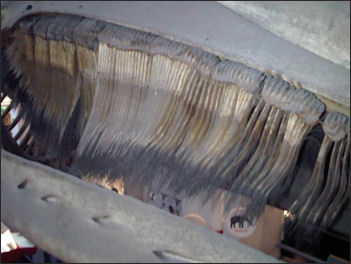
Gray whale baleen Baleens are bristle-like sheets of horn, feathered at the edges that hang down like stiff curtains from the upper jaw. They are made from keratin the same stiff material that forms mammal hair and claws and human fingernails. Baleen is a skin derivative. Some whales, such as the bowhead whale, have longer baleen than others. Other whales, such as the gray whale, only use one side of their baleen.
Depending on the species, a baleen plate can be 0.5 to 3.5 meters (1.6 to 11.5 feet) in length and weigh up to 90 kilograms (200 pounds). The hairy fringes are called baleen hair or whalebone hair. They are also called baleen bristles, which in sei whales are highly calcified, with calcification functioning to increase their stiffness. Baleen plates are broader at the gumline (base). The plates have been compared to sieves or Venetian blinds. In the old days flexible baleen was used to make corsets, umbrella ribs, clock springs and riding whips. It was usually called whalebone, which is a misnomer.
Baleen Whale Feeding Organ
Rorqual whales, which include blue, fin and minke whales, have a special sensory organ in their jaws which helps them regulate their unique baleen feeding methods. Live Science reported: Whales that feed by taking big gulps of the ocean have a special sensory organ in the middle of their jaws that helps them regulate their unique feeding methods, researchers found. The once-hidden organ prevents injury as the whales gulp whale-size mouthfuls of water. "We think this sensory organ sends information to the brain in order to coordinate the complex mechanism of lunge-feeding, which involves rotating the jaws, inverting the tongue and expanding the throat pleats and blubber layer," study researcher Nick Pyenson, of the Smithsonian Institution, said. [Source: Jennifer Welsh, Livescience, May 24, 2012
The researchers studied rorqual whales, the largest group of baleen whales. They include nine species like the blue whale, which can weigh up to 165 tons (150 metric tonnes). The smallest rorqual whale is the northern minke whale, which weighs in at nearly 10 tons (9 metric tonnes). To feed, a rorqual whale will lunge at a spot in the water, open its mouth hugely wide, stretching a large patch of soft tissue between its jaws, and engulfing a school of fish or tiny shrimp-like krill and water about the size of the whale itself in one bite. The process takes about six seconds. The water then gets filtered back into the ocean through baleen at the front of the whale's mouth, which slowly returns to normal size while retaining the food caught.
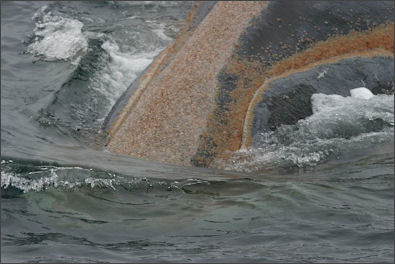
Orange whale lice on a right whale To facilitate this type of feeding the whales have two large connected jawbones very loosely attached to the rest of their skull. The researchers studied the connection between these two bones in fin and minke whales, both young and old specimens, which were caught commercially in Iceland. The researchers discovered a special new organ in the cartilage joint between these two elastic jawbones. The organ is about the size of a grapefruit, and is full of nerves and blood vessels, which seem to feed into structures in the mouth that detect changes in pressure, called mechanoreceptors.
These mechanoreceptors seem to respond to the rotation of the whale's jaws while the mouth is opening, something that puts pressure on the joint between the jawbones; the receptors also sense the expansion of the soft tissue inside the mouth. The changes the organ senses are sent back to the brain, to help coordinate feeding, the researchers suspect. The information could be used to regulate how fast the mouth opens and how much the throat pouch expands to maximize the volume of water captured, all without overdoing the amount of stress put on the jaw and mouth. "In terms of evolution, the innovation of this sensory organ has a fundamental role in one of the most extreme feeding methods of aquatic creatures," study researcher Bob Shadwick, of the University of British Columbia, said in a statement. Shadwick added that lunge-feeding adaptations appear to have evolved before today's whales ballooned in size. As such, he said, "it's likely that this sensory organ — and its role in coordinating successful lunging — is responsible for rorquals claiming the largest-animals-on-Earth status."
Whale Predators, Parasites and Illnesses
Whales have few natural predators other than other whales, namely orcas (killer whales) and sometimes sharks. Small toothed whales rely on their speed and agility to escape predators. Humans prey on whales throughout the world. Orcas have been observed attacking grays, humpbacks, rights, bryde's, minkes, sperm whales, even blue whales, as well as dolphins. Large sharks are known to feed on porpoises, dolphins and whale carcasses but rarely feed on living whales.
Whales may contain many parasities. The number of parasites may be related to the swimming speed. The pace slower whales is thought to allow accumulation of parasites to occur. Whales have different types of whale lice living in their scars, scratches, chins, throats, and urogenital slits. Barnacles also live in their throats, chins, and urogenital slits. Some endoparasites that live within the whales are trematodes, cestodes, nematodes, acanthocephalans. Helminths live in the blubber, liver, mesentery, and intestine, while Ogmogaster ceti (a commensal nematode specific to the Balaenopteridae) lives in the baleen plates. [Source: Mindy B. Kurlansky, Animal Diversity Web]
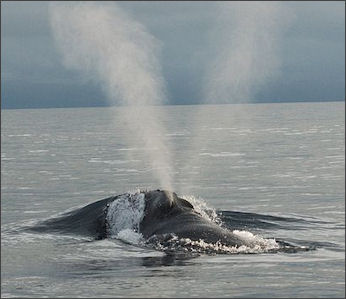
right whale blowhole Barnacles and other creatures often attach themselves to whales. They accumulate in cold water and often drop off in warmer water. Humpbacks in the Arctic accumulate up to a half ton of barnacles. Right whale, who also spend a lot of time in cold water, accumulate a lot. Remoras sometimes follow whales around and seabirds land on them. Melville wrote, "Sea fowls are pecking at the small crabs, shellfish, and other sea candies and macaroni, which the Right Whale sometimes carries on his pestilent back."
Whales suffer from a number of ailments that affect humans, including ulcers, teeth cavities and tonsillitis. True rorquals get cirrhosis of the liver and mastitis. Some whales have whitish, oval-shaped scars, which are the marks of parasitic sea lampreys. Others are scarred by cookie-cutter sharks.A number of internal parasites such as 50-foot-long tapeworms have been in whale’s liver, stomach, intestines, lungs, kidneys and brain. One sperm whale was found with 110 pounds of nematodes in its stomach. Whale snouts are often laden with whale lice. They also suffer terribly from inner ear parasites. Whale lice are often benign and even helpful, consuming dead skin.
Sunburned Whales Maybe Caused by the Ozone Hole
In November 2010, “Some whale species off the Mexican coast are showing signs of severe sunburn that might be caused by the damaged ozone layer's decreased ability to block ultraviolet radiation, a study concluded. The seagoing mammals would be particularly vulnerable to the sun damage in part because they need to spend extended periods of time on the ocean's surface to breathe, socialize, and feed their young. Since they don't have fur or feathers, that effectively means they sunbathe naked. [Source: AP, November 10, 2010]
As Laura Martinez-Levasseur, the study's lead author, put it: "Humans can put on clothes or sunglasses — whales can't." Martinez-Levasseur, who works at the Zoological Society of London, spent three years studying whales in the Gulf of California, the teeming body of water that separates Baja California from the Mexican mainland.
Photographs were taken of the whales to chart any visible damage, and small samples — taken with a crossbow-fired dart — were collected to examine the state of their skin cells. Her study, published in the Proceedings of the Royal Society B, seemed to confirm suspicions first raised by one of her whale-watching colleagues: The beasts were showing lesions associated with sun damage, and many of their skin samples revealed patterns of dead cells associated with exposure to the powerful ultraviolet radiation emitted by the sun.
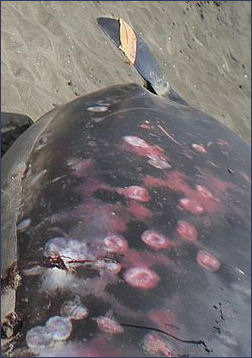
Scars from cookie-cutter shark
bites on Gray's beaked whale As with humans, the lighter-skinned whales seemed to have the most difficulty dealing with the sun. Blue whales had more severe skin damage than their darker-skinned counterparts, fin whales and sperm whales, even though the latter spend bigger chunks of time at the surface. "A likely candidate is rising UVR as a result of either ozone depletion, or a change in the level of cloud cover," Martinez-Levasseur added. The ozone layer, which helps insulate Earth from ultraviolet rays, has been thinning for years under the influence of ozone-eating chemicals known as CFCs. The emission of those chemicals has since largely been curbed, and the ozone layer is undergoing a slow recovery.
For whales, the potential danger from the sun's rays are just one more environmental stress. All species tracked in this study are considered endangered or vulnerable by the International Union for Conservation of Nature. If it's shown that the skin damage is leading to cancer, then "this could be a serious threat," according to Simon Ingram, who teaches marine conservation at England's University of Plymouth and wasn't involved with the study.
So far, there were no indications of skin cancer among the whales studied, although Martinez-Levasseur noted that only tiny samples were taken of the massive animals. She said one of her next projects will be to examine how well whales' cells hold up under the increased ultraviolet radiation — and whether whales' pigmentation darkens as a result of their time spent out in the sun. In other words, she wants "to be able to see if they're tanning."
Whale Fall and Marine Snow
A dead whale can deliver the equivalency of 2000 years of “marine snow” to the bottom of the ocean. Marine snow is made of bits dead marine life and other organic matter that gently falls through the water column and settles on the sea floor, providing food for many creatures on the sea bottom and in deep water. In the early 2000s, Scientists discovered two new of species worm living in the bones of dead whales found off the California coast.
When whales die and sink, their carcasses — known as whale falls — provide a bounty of nutrients for deepwater creatures. During a 2019 expedition, researchers discovered a whale fall at 3,238 meters (10,623 feet) below the surface near Davidson Seamount in NOAA's Monterey Bay National Marine Sanctuary. [Source: NOAA]
The ocean's depths are supplied by nutrients falling down from the surface waters.Different stages in the decomposition of a whale carcass support a succession of marine biological communities. Scavengers consume the soft tissue in a matter of months. Organic fragments, or detritus, enrich the sediments nearby for over a year.
The whale skeleton can support rich communities for years to decades, both as a hard substrate (or surface) for invertebrate colonization and as a source of sulfides from the decay of organic compounds of whale bones. Microbes live off of the energy released from these chemical reactions and form the basis of ecosystems for as long as the food source lasts. At deep sea levels this forms a new food web and provides energy to support single- and multi-cell organisms and sponges, thus adding to the ocean's food chain.
Image Source: Wikimedia Commons, NOAA
Text Sources: Animal Diversity Web (ADW) animaldiversity.org; National Oceanic and Atmospheric Administration (NOAA) noaa.gov; Wikipedia, National Geographic, Live Science, BBC, Smithsonian, New York Times, Washington Post, Los Angeles Times, The New Yorker, Reuters, Associated Press, Lonely Planet Guides and various books and other publications.
Last Updated June 2023
